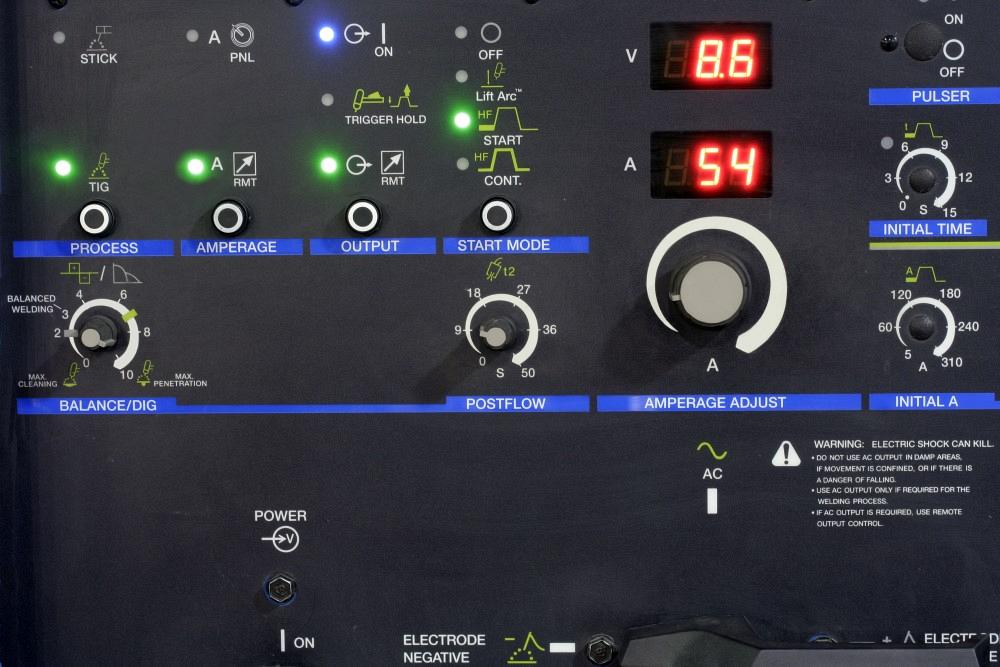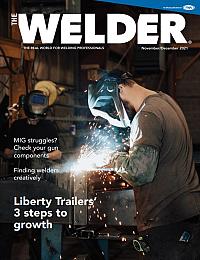Technical Liaison Manager
- FMA
- The Fabricator
- FABTECH
- Canadian Metalworking
Categories
- Additive Manufacturing
- Aluminum Welding
- Arc Welding
- Assembly and Joining
- Automation and Robotics
- Bending and Forming
- Consumables
- Cutting and Weld Prep
- Electric Vehicles
- En Español
- Finishing
- Hydroforming
- Laser Cutting
- Laser Welding
- Machining
- Manufacturing Software
- Materials Handling
- Metals/Materials
- Oxyfuel Cutting
- Plasma Cutting
- Power Tools
- Punching and Other Holemaking
- Roll Forming
- Safety
- Sawing
- Shearing
- Shop Management
- Testing and Measuring
- Tube and Pipe Fabrication
- Tube and Pipe Production
- Waterjet Cutting
Industry Directory
Webcasts
Podcasts
FAB 40
Advertise
Subscribe
Account Login
Search
Consumables Corner: Why are welders experiencing amperage variation on machines doing the same work?
- By David Meyer and Rob Koltz
- December 13, 2021
- Article
- Consumables

The Consumables Corner team explains why the same welding parameters sometimes result in different amperages during wire feed welding processes. Getty Images
Q: I recently started a small weld shop where we use FCAW and GMAW with argon/carbon dioxide shielding gas. I noticed that even though our welders were using the same wire, voltage, and wire feed speed, the amperage readings on their machines were different. In fact, they varied by as much as 40 amps. What is causing this, and are there any weld quality concerns because of this?
A: The amperage variation is rather common with manual wire feed welding processes. Let’s review welding parameters and their relationship to weld performance.
The key welding parameters related to manual wire feed welding are voltage, wire feed speed (WFS), amperage, and contact-tip-to-work distance (CTTWD). These four variables are directly responsible for the electrical characteristics of the welding arc and the numbers displayed on the welding power source. Shielding gas type and flow rate are other important variables, but we will focus on the electrical circuit portion of the process.
In most applications, manual wire feed welding uses a constant-voltage (CV) welding power source. A CV machine operates by setting a predetermined voltage and WFS, and amperage is a result of the amount of energy required to melt the wire at the preset value, which is directly related to the CTTWD maintained by the welder. This type of power source produces a consistent, stable arc and provides the welder with good control over the weld puddle, allowing for a uniform weld bead.
Voltage controls the length of the welding arc, which is the distance measured from the weld puddle to the point where the wire is melting as it feeds from the end of the welding gun. CV welding power sources maintain voltage consistently during the welding process. Voltage’s influence on the weld bead is primarily reflected in bead width, shape, and fusion at the toes of the weld, among a few other things.
WFS is a preset value on the wire feeder and remains constant during welding with a CV welding power source. Conversely, if a constant-current (CC) welding power source were used, the amperage would be preset and maintained, and the WFS would fluctuate depending on the CTTWD and voltage output of the machine.
Amperage is the amount of electron flow through the electrical arc circuit. It is directly related to the preset WFS. An increased WFS results in higher amperage, and low WFS results in lower amperage. Amperage is responsible for how deep the welding arc penetrates the base material, assuming you are using the proper welding techniques, shielding gas, and weld joint design.
CTTWD is the distance measured from the weld puddle to the end of the contact tip. This is sometimes referred to as electrical stick-out (ESO). However, ESO is the distance measured from the end of the contact tip to the point where the wire melts during the welding process. This dimension has a moderate influence on welding amperage.
When you set your voltage and WFS and maintain a specific CTTWD, you will achieve a specific amperage. If you increase or decrease the CTTWD, the amperage will decrease or increase in inverse proportion to the CTTWD. Therefore, you are seeing varying amperage readings even when your welders are using the same preset parameters because their CTTWD lengths are what is different.
During welding, the amount of ESO or unmelted wire is affected by a phenomenon called wire preheating. Electrical circuits have three main components: voltage, amperage, and resistance. Likewise, in a welding circuit, the same variables exist, and one location of resistance is within the wire electrode between the welding arc and contact tip. The resistance in this section of wire increases with increasing length, resulting in lower amperage readings. An experienced welder will take advantage of this concept to fill in gaps on thin materials to prevent burning through.
As mentioned, amperage is largely responsible for depth of weld penetration. If you increase the CTTWD, the voltage or arc length will not change, but the resistance increases, resulting in lower amperage and less penetration. From a weld quality perspective, you may experience a lack of fusion at the root of the weld bead or produce a poor weld surface profile. Excessive CTTWD can lead to poor shielding gas coverage, potentially causing weld porosity issues as well.
About the Authors


Rob Koltz
Application Engineer
411 S. Ebenezer Rd.
Florence, 29501
636-485-2253
About the Publication
Related Companies
subscribe now

The Welder, formerly known as Practical Welding Today, is a showcase of the real people who make the products we use and work with every day. This magazine has served the welding community in North America well for more than 20 years.
start your free subscription- Stay connected from anywhere

Easily access valuable industry resources now with full access to the digital edition of The Fabricator.

Easily access valuable industry resources now with full access to the digital edition of The Welder.

Easily access valuable industry resources now with full access to the digital edition of The Tube and Pipe Journal.
- Podcasting
- Podcast:
- The Fabricator Podcast
- Published:
- 04/16/2024
- Running Time:
- 63:29
In this episode of The Fabricator Podcast, Caleb Chamberlain, co-founder and CEO of OSH Cut, discusses his company’s...
- Industry Events
16th Annual Safety Conference
- April 30 - May 1, 2024
- Elgin,
Pipe and Tube Conference
- May 21 - 22, 2024
- Omaha, NE
World-Class Roll Forming Workshop
- June 5 - 6, 2024
- Louisville, KY
Advanced Laser Application Workshop
- June 25 - 27, 2024
- Novi, MI
































